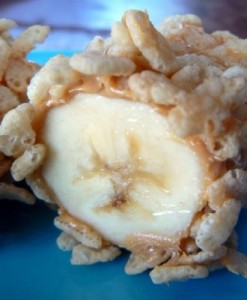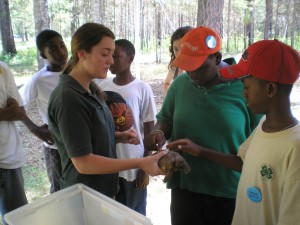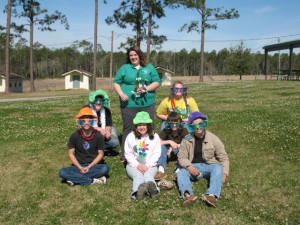by Melanie Taylor | Jul 19, 2013
From the sand to the ocean, camp to the pool, water parks to the playground – summer usually means high-energy for kids enjoying time off from school. It’s a good idea to keep on hand a stash of cooling, nutritious snacks to satisfy ferocious appetites and picky palates.
One such snack for high energy kids is called BANANA SUSHI… Sushi is a Japanese food consisting of cooked rice, combined with other ingredients, usually raw fish or other seafood. Sushi is unique based on the preparation method and how it’s rolled up and sliced into bite size pieces. This is a unique teaching opportunity to discuss the Japanese culture and its different style of foods and eating methods. When you use this recipe, explain to the kids they will be making their own fun and tasty version of Sushi using bananas.

Banana Sushi
Prep Time: 5 minutes
Total Time: 5 minutes
Ingredients:
Banana, peanut butter, rice krispies cereal
Directions:
- Coat a banana with peanut butter. (For a cool treat on an especially hot day freeze the banana several hours before preparing.)
- Roll in rice krispies cereal.
- Slice into bite size pieces (like sushi).
- Eat and Enjoy!
- Encourage the kids to use chopsticks and to learn more about Japanese eating utensils.
Here are some more healthy and refreshing DIY treats that kids of all ages can prepare on their own or in group settings such as day camps and 4-H club meetings:
•Make your own trail mix with a combination of nuts, dried fruit, dark chocolate chips, and cereal pieces. Try a selection of several healthy cereals, pretzels, nuts, and crackers.
•Dried fruit – banana chips, mango, and apple, papaya, pear, or peach slices.
•Plain popcorn sprinkled with Parmesan cheese or flavorful spices.
•Baked pita or bagel chips dipped in cool, refreshing hummus.
•Skewer cubes of firm cheese (cheddar, Swiss, Monterey Jack), alternated with chunks of fresh summer fruits.
•Fresh fruit salad – Cut up apples, pineapple, bananas, oranges, and berries or any fresh, in-season fruits. Throw in dried cranberries or raisins, and sunflower seeds or slivered almonds. Top with a dollop of yogurt.
•Berry parfaits – Layer fresh berries with granola and yogurt or freshly whipped cream.
Of course, as you make theses treats with your 4-Hers be sure to incorporate the importance of their nutritional value to their daily intake based on the current MyPlate recommendation. You can find more kid-friendly information on MyPlate at http://www.choosemyplate.gov.
by Marcus Boston Jr. | Mar 15, 2013

Youth learn about the habitat and calm nature of the Gopher Tortoise at the 4-H Wildiife and Outdoor Recreation Camp
Many youth today are suffering from a serious, preventable disorder that is the result of early age experiences and if not properly diagnosed or treated, may cause severe mental health issues up through adulthood. This disorder I’m referring to is called Videophilia. Videophilia can be described as the love of any form of electronic media. This media may be internet, movies, video games, cell phones, or just plain TV. Many youth are so attached to their video devices that they hardly ever go outside to see what’s going on in the natural world. In Richard Louv’s book “Last Child in the Woods” he calls this condition “Nature-Deficit Disorder”.
According to the Center for Environmental Health, consistent contact with nature has many health benefits including helping to ease attention-deficit disorder, aiding in cognitive development, enhancing creativity, and reducing stress. With so much emphasis on our communities becoming more sustainable in how they utilize resources, many environmentalist fear that the loss of contact with nature will weaken Americans commitments to conservation and biodiversity. These concepts will have more impact to the future of our world if they are introduced to youth as they matriculate through grade school. The earlier we teach them how to enjoy the great outdoors the better!
What is nature you may ask?? Nature can be Yellowstone National Park, The Appalachia National Forest, or it could be a clump of trees at the back of a neighborhood or in someone’s yard. To the scientific eye the clump of trees might not look like much but to a child it could be a life changing experience. Every 4-H club agenda that is developed should include a nature walk or some other outdoor activity. Additionally, 4-H residential and day camps provide perfect opportunities for both youth and adults to explore the great outdoors together. Most electronic programs and activities only require hearing and seeing, however providing an outdoor experience for 4-H youth will provide opportunities to hear, smell, touch, see and sometimes taste. Nature Deficit Disorder may be a growing disorder, but lucky for us, with programs like 4-H and great volunteers, it is a disorder that can be easily cured!
by Whitney Cherry | Jan 18, 2013
 Although we live in the Sunshine State, we still have to deal with a few days of cold weather. When it’s cold out, it can be hard for youth and their parents to get the 60 minutes of daily physical activity recommended by health officials. If families do venture out into the cold to exercise, it is crucial that family members dress appropriately to prevent too much heat loss. Here are a few tips to remember when exercising in cold weather. (more…)
Although we live in the Sunshine State, we still have to deal with a few days of cold weather. When it’s cold out, it can be hard for youth and their parents to get the 60 minutes of daily physical activity recommended by health officials. If families do venture out into the cold to exercise, it is crucial that family members dress appropriately to prevent too much heat loss. Here are a few tips to remember when exercising in cold weather. (more…)
by Sherri Kraeft | Nov 26, 2012
When most of us go to the pantry to make a peanut butter and jelly sandwich, we don’t think about where the ingredients come from. We all know that peanuts go into the peanut butter and grapes and sugar make the jelly, but what about the bread itself?
There are four main ingredients in any basic bread and its uses and variations are endless. Basic bread recipes usually include flour, water, yeast, sugar.
While working with 4-H youth in a cooking project, why not try to encourage them to make their own variation of plain bread and have some fun?
Some of the many varieties you can bake are: French peasant bread, honey wheat bread and Italian loaf. Click on any of the following links to get great bread-baking tips and recipes to use with kids. Who knows, they may come up with a great variety of their own!

As a volunteer, we encourage youth to develop their own ideas and exert their independence by experimenting within the safety of a 4-H Club environment. Here are some other ideas for extensions of a simple bread-baking activity with youth that incorporate the four essential elements:
Mastery – Have a bread tasting contest and incorporate a skill-a-thon with measurements, tools and ingredients from basic breads to fancy, specialty items.
Gennerosity – Youth can have a Bake-A-Thon or Bake Sale and give all proceeds and products to a local shelter, food bank or food ministry. Students can also make gifts of bread and products that they have made for relatives and other club members.
Belonging – Since all youth like to share their creations, make a collage of pictures of everyone baking and sampling their breads to post to a local website, newspaper or social media page. This is also a great way to raise awareness for local 4-H clubs and their activities.
Independence – Allow 4-Hers to visit a local bakery and ask questions about their business model and how they got started. This allows youth to seejobs and careers related to their interests in the community.
Some other resources are:
http://www.bakingmad.com/kids/getting-kids-interested-in-cooking.
http://www.bakingmad.com/recipes/whitebreads
http://www.perishablenews.com/index.php?article=0018522
http://www.bettycrocker.com/tips/bakewithkids
by Allison Meharg | Nov 26, 2012
As we roll from fall into winter, many of us begin pulling out the warm clothes and preparing for some time indoors. We have such beautiful weather along the gulf coast that most of us usually dread the end of summer. However, this time of year doesn’t have to be the end of all the fun! Many of our 4-H clubs have started projects in natural resources. They’re exploring the outdoors through hiking, biking, camping, bird watching, and GIS. This is the perfect time of the year to start off a club project in one of these areas. The weather is perfect and the changing seasons provide a wonderful educational opportunity for youth of all ages to see our native ecosystems. Youth can incorporate science, technology, math, art, and healthy lifestyles into one project. A few examples are listed below:
– Take your members on a hiking trip to a local state park! Members should be divided into groups of 3-5 and provided with a local wildlife guide and some type of device to take photos. Each group will have 45 minutes to find, identify, and photograph 5-10 native animals or plants. The first group back the starting point wins a prize!
– Early winter is perfect for a casual bike ride. Take members out on a local closed bike path and ride a couple miles. To break up the distance, stop at various points along the way to identify native trees, plants, wildlife, or areas where the ecosystems change. Youth can also make their own trail mix or flavored fruit water to take along with them as a healthy alternative to candy bars and soda.
– Provide each member with a strip of different color shades from the paint store. As you hike they should look for the colors in the landscape. As they identify one, have their leader punch a hole in that paint chip. Members will see the wide variety of colors within the native area.
– If your local club or county has GPS units, go on a treasure hunt! Out together These hunts are becoming more popular and a great way to work on direction, map reading, and using technology.
These are just a few of the activities your club could do outdoors. It could be as simple as moving a club meeting to an outdoor area or having a parent/member picnic. The outdoors provide us a great opportunity to build on all types of skills, so don’t miss out: Explore the Outdoors!





